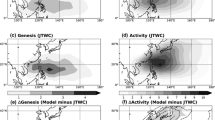Abstract
The precipitation distributions associated with two landfalling tropical cyclones (TCs) during extratropical transition (ET) were examined in this study. Their distinction is that the bulk of precipitation fell to the left of the TC track in one TC and to the right in the other. The analyses indicate that, for the TC Haima (2004) case, accompanied by the approach of a deep midlatitude trough throughout the depth of the troposphere, the warm and moist air advection by the southeasterly flow north of TC was favorable for warm advection and frontogenesis to the northwest of the TC. Due to the steepening of equivalent potential temperature (θ e), the air-parcel uplift along the θ e surface, in collaboration with thermally direct circulation related to frontogenesis, led to enhanced precipitation northwest of the TC. In contrast, for TC Matsa (2005) embedded within a moister environment, a weak midlatitude trough was situated at the mid-upper level. The convection was triggered by the conditional instability at the lower level and then sustained by dynamic forcing at the mid-upper level so that the heavy precipitation occurred to the northeast of TC. For the two TC cases, the precipitation enhancement was also linked to the upper-level anomalous divergence associated with the jet-related forcing on the right side of the jet entrance. From the quasigeostrophic perspective, the advection of geostrophic absolute vorticity by the thermal wind most likely served as an indication reflecting the displacement of the vertical motion relative to the center of the TC.
Similar content being viewed by others
References
Atallah, E. H., and L. F. Bosart, 2003: The extratropical transition and precipitation distribution of Hurricane Floyd (1999). Mon. Wea. Rev., 131, 1063–1081.
Atallah, E. H., L. F. Bosart, and A. R. Aiyyer, 2007: Precipitation distribution associated with landfalling tropical cyclones over the eastern United States. Mon. Wea. Rev., 135, 2185–2206.
Bosart, L. F., and D. B. Dean, 1991: The Agnes rainstorm of June 1972: Surface feature evolution culminating in inland storm redevelopment. Wea. Forecasting, 6, 515–537.
Chen, L. S., and Y. H. Ding, 1979: An Introduction to the Western Pacific Typhoon. Science Press, Beijing, 491pp. (in Chinese)
DiMego, G. J., and L. F. Bosart, 1982: The transformation of Tropical Storm Agnes into an extratropical cyclone. Part II: Moisture, vorticity and kinetic energy budgets. Mon. Wea. Rev., 110, 412–433.
Foley, G. R., and B. N. Hanstrum, 1994: The capture of tropical cyclones by cold fronts off the west coast of Australia. Wea. Forecasting, 9, 577–592.
Hart, R. E., 2003: A cyclone phase space derived from thermal wind and thermal asymmetry. Mon. Wea. Rev., 131, 585–616.
Hart, R. E., and J. L. Evans, 2001: A climatology of the extratropical transition of Atlantic tropical cyclones. J. Climate, 14, 546–564.
Jones, S. C., and Coauthors, 2003: The extratropical transition of tropical cyclones: Forecast challenges, current understanding, and future directions. Wea. Forecasting, 18, 1052–1092.
Kitabatake, N., 2002: Extratropical transformation of Typhoon Vicki (9807): Structural change and the role of upper-tropospheric disturbances. J. Meteor. Soc. Japan, 80, 229–247.
Kitabatake, N., 2008a: Extratropical transition of Typhoon Tokage (0423) and associated heavy rainfall on the left side of its track over western Japan. Pap. Meteor. Geophys., 59, 97–114.
Kitabatake, N., 2008b: Extratropical transition of tropical cyclones in the western North Pacific: Their frontal evolution. Mon. Wea. Rev., 136, 2066–2090.
Klein, P. M., P. A. Harr, and R. L. Elsberry, 2000: Extratropical transition of western North Pacific tropical cyclones: An overview and conceptual model of the transformation stage. Wea. Forecasting, 15, 373–396.
Li, Y., L. S. Chen, and X. T. Lei, 2008: Frontogenesis in the circulation of Typhoon Winnie (1997) during its extratropical transition process. Chinese J. Atmos. Sci., 32(3), 629–639. (in Chinese)
Liang, J., L. S. Chen, Y., Li, C. F. Zhang, and X. M. Zhang, 2008: Impacts of tropical cyclone extratropical transition on the rainfall over the Liaodong Peninsula. Journal of Tropical Meteorology, 24, 449–458. (in Chinese)
Marks, F., 1985: Evolution of the structure of precipitation in Hurricane Allen (1980). Mon. Wea. Rev., 113, 909–930.
Merrill, R. T., 1993: Tropical cyclone structure. Global Guide to Tropical Cyclone Forecasting, WMO/TDNo. 560, Rep. TCP-31, World Meteorological Organization, Geneva, Switzerland, 2.1-2.60.
Molinari, J., S. Skubis, and D. Vollaro, 1995: External influences on hurricane intensity. Part III: Potential vorticity structure. J. Atmos. Sci., 52, 3593–3606.
Molinari, J., S. Skubis, D. Vollaro, F. Alsheimer, and H. E. Willoughby, 1998: Potential vorticity analysis of tropical cyclone intensification. J. Atmos. Sci., 55, 2632–2644.
Onogi, K., and Coauthors, 2007: The JRA-25 Reanalysis. J. Meteol. Soc. Japan, 85, 369–432.
Sinclair, M. R., 1993: A diagnostic study of the extratropical precipitation resulting from Cyclone Bola. Mon. Wea. Rev., 121, 2690–2707.
Sinclair, M. R., 2002: Extratropical transition of southwest Pacific tropical cyclones. Part I: Climatology and mean structure changes. Mon. Wea. Rev., 130, 590–609.
Sun, J. H., and S. X. Zhao, 2000: Diagnoses and Simulations of Typhoon (Tim) Landing and Producing Heavy Rainfall in China. Chinese J. Atmos. Sci., 24(2), 223–237. (in Chinese)
Trenberth, K. E., 1978: On the interpretation of the diagnostic quasigeostrophic omega equation. Mon. Wea. Rev., 106, 131–137.
Zhu, P. J., Y. G. Zheng, C. X. Zhang, and Z. Y. Tao, 2005: A study of the extratropical transformation of Typhoon Winnie (1997). Adv. Atmos. Sci., 22, 730–740.
Author information
Authors and Affiliations
Corresponding author
Rights and permissions
About this article
Cite this article
Chen, G. A Comparison of precipitation distribution of two landfalling tropical cyclones during the extratropical transition. Adv. Atmos. Sci. 28, 1390–1404 (2011). https://doi.org/10.1007/s00376-011-0148-y
Received:
Revised:
Published:
Issue Date:
DOI: https://doi.org/10.1007/s00376-011-0148-y




